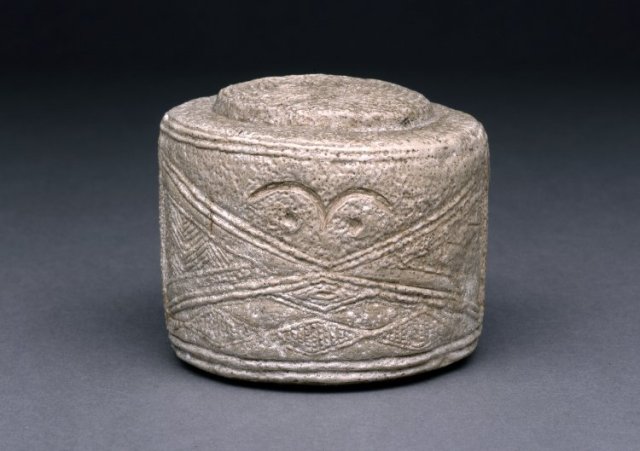A new analysis of the mysterious chalk Folkton Drums has been published in Antiquity journal as “Digital imaging and prehistoric imagery: a new analysis of the Folkton Drums” (though sadly it’s behind a paywall). Here’s the abstract:
“The Folkton ‘Drums’ constitute three of the most remarkable decorated objects from Neolithic Britain. New analysis using Reflectance Transformation Imaging and photogrammetry has revealed evidence for previously unrecorded motifs, erasure and reworking. Hence these chalk drums were not decorated according to a single, pre-ordained scheme, but were successively carved and re-carved over time. Such practices may have been widespread in the making of artefacts in Neolithic Britain. The study of these drums also demonstrates the ability of these new techniques not only to record visible motifs, but to document erased and reworked motifs clearly.”

And here’s a British Museum picture of one of the sides of one of the drums. Now… if one knows the complex duality of meaning of Anglo-Saxon symbolism, and also the ancient British regard for a ‘sacred’ trinity occurring within a natural landscape (the meeting of three watercourses, for instance), then one might hazard a ‘reading back’ of such archaic understandings into these more distant Neolithic drums. For instance, just taking one side of a drum, one might read it thus…
Obvious meaning: the human face. The drums were found in a child’s grave.
A possible deeper and simultaneous meaning: The three diamond-shaped “fields” in the lower section suggest that this picture can be read as a landscape view. The notion that this is a symbolic landscape then leads one to see the central symbol as being that of large hawk, swan or sea-bird gliding down a symbolic valley landscape, with the three cultivated fields (or perhaps fish-ponds) situated below the bird. The two ‘eye’ dots might then be understood to symbolise the two full moons that marked out a Neolithic month. The bird would thus be a potent symbol of the fleeting nature of action/life within the eternal cycle of the sky (of course, we already know that birds — especially waterbirds — had a special place in ancient British mythologies). The ‘mouth’ might then be understood as the outlet of a natural spring, and the herringbone patterns either side of it might then symbolise the rainwater stored within the hills, water which fed down into the spring mouth. A landscape trinity of sky / valley hillsides / cultivated lowland is then, in this reading, clearly demarcated by the deep lines that cross in a clearly-incised ‘X’. The picture, understood in this manner, becomes a poignant evocation the fleeting natural cycle within a landscape — and thus a fitting grave item.

